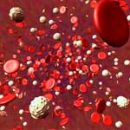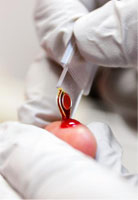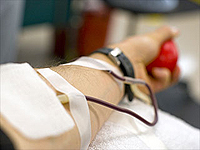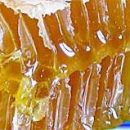What is a gravitational blood surgery? In the therapy of what diseases plasmapheresis is applied? What complications are fraught with this procedure? Answers to these questions you will find in this article.
Content
In recent years, various methods of elecorporal blood purification are widely used in world clinical practice with different diseases and pathological conditions, accompanied by severe toxicosis, cluster in the blood of pathological products - substances of supporting and aggressive course of disease.
It is possible to distinguish 3 fundamentally different directions in the purification of blood: hemodialysis (the use of membranes with a certain bandwidth), hemosorption (blood perfusion through sorbents - activated carbon, resins), plasmatsitafferesis, in which, under the action of gravity (precipitation, centrifugation), solid blood is resolve by Components (due to different density) and removes. This direction got the name of gravitational blood surgery.
From the methods of gravitational blood surgery, the use of plasmapheresis is the most common. Term «Plasmapheres» (from Greek «Aferesis» - Removal), denoting the process of selective removal of liquid blood (plasma), proposed in 1914. YU. Abel, which used this procedure in the experimental development of artificial kidneys in dogs. The idea of clinical use of plasmapheresis, put forward in 1925. N. NS. Mikhailovsky, was based on the possibility of elimination (removal) from the body together with the plasma of excess physiological and pathological products.
Another fundamental point is the replacement of remote plasma of a full-fledged donor or the introduction of insufficient blood components.
Currently developed several methods of blood separation into components under the action of gravity forces.
The simplest method of holding plasmapheresis is an ordinary blood settling in bottles containing an anticoagulant (heparin, sodium citrate, preventing the development of blood coagulation during its upstream). Already 2-3 hours after the cells are sedentary, two layers are formed: upper - plasma, lower - blood cells. Plasma is removed, and cells are returned to the bloodstream to the patient. The method was called manual plasmapheres; The procedure takes a lot of time, the amount of plasma removed is small. It is used in blood diseases (paraproteinemic hemoblastosis) when the erythrocyte sedimentation speed is high.
Intermittent plasmapheresis using plastic containers and refrigerated centrifuges expanded the possibility of applying a method with therapeutic purposes. The method is simple, convenient that does not require expensive equipment, is easily transferred to patients, has a minimum number of complications, side effects. This is the most promising of all methods of plasmapheresis, most often used.
The procedure is as follows. Downtown elbow vein, and with a poorly pronounced venous system, a subclavian vein (according to the Merding Guard procedure). Blood enters a plastic container with a capacity of 500 ml, where stirred with anticoagulant. After filling in blood, the bag is disconnected from the needle (or catheter), instead of it joins the bottle with the recovery blood loss with a solution introduced into the same vein drip. The bag at this time is centrifuged in the refrigerated centrifuge (for 15-30 minutes at 2500-3000 rpm), after which the plasma is removed from it (300-350 ml). The remaining cell mass is diluted with saline (100-150 ml), and again through the same needle (or catheter) after turning off the bottle with a recoverable solution, the patient's blood circuit is introduced into the blood circuit. Such a procedure is carried out from 1 to 4 times per session, depending on the set of factors (diseases, the state of the patient, the initial laboratory changes in blood, etc.). Sessions are held after 1-3 days, the course of treatment is 1-5 sessions, session duration 1.2-3 hours.
It can be noted that the patients are worried, worried only during the first session, and to subsequent plasmapheresis procedures, especially when the clinical effect appears, are calm and with desire.
In the 60s, the Group of Scientists of the National Institute (USA) has created a special blood separator (Machine Plasmapheresis). Using the centrifugation, the separation occurs in a bowl-rotor on different modes. Blood through plastic tubular pipelines with peristaltic pumps enters thickets, the rotor rotates at high speed, and blood is divided into plasma and cell elements (platelets, blood plates, leukocytes, red blood cells). Then (again, with the help of pumps), blood fraction is removed from the rotor, the cells are returned to the patient.
Separators can work in continuous mode (blood fills the bowl, centrifuged and deleted after the stop). The machine method allows you to perform intense plasmapheresis with the removal of large amounts of plasma (up to 3-4 liters per session).
The blood plasma is constantly circulating antibodies, immune complexes, metabolic products of different cells (to be removed from the body, intermediate - those of various cells and tissues), the components of the destroyed, old and defective cells, which are allocated by them enzymes, local hormones, peptides and Other substances, among which have products with toxic effect: bilirubin, bile acids, endotoxins, kinins, tripsin, serotonin, etc. Normally, the process of digestion and removal of cell substrates and metabolic products from the body. This process is violated in the pathology of the purification (liver, kidney, spleen, lungs), defects of the phagocytic - macrophagia system, as well as in developing or forming an excess of products to be removed.
This is most pronounced with immuno-complex pathology (based on it is based on the damaging effect on the tissue of circulating immune complexes), with massive burns (when a large amount of toxic substances from affected tissues flow into the bloodstream), acute infections, hemolytic processes (when blood cells are destroyed ), radiation and cytostatic diseases. The inclusion of plasmapheresis into comprehensive data therapy of pathologies allows to obtain very effective treatment results, and in certain cases it is even necessary to save the life of patients.
Mechanism of therapeutic action of plasmapheresis of multilateral. First of all, direct elimination along with plasma of toxic products from the bloodstream of patient, bacterial bodies and their toxins, paraproteins, cryoglobulins, tissue decay products, destroyed blood cells, circulating complexes of antigen - antibody, complement components, killer cells, lysosomal enzymes, kinines and other factors determining the pathological process.
After plasmapheresis, there was a common effect of blood loss (in antiquity it was noticed by doctors: the bloodletting with a certain effect was used in the treatment of different diseases), the system of nonspecific protection is released, microcirculation in all parenchymal organs is improved, reduced stagnation in capillaries and arteriols, tissue breathing improves Osmolarity and oncotical plasma pressure - blood liquefaction (hemodilution) due to plasma output from tissues.
Along with the plasma, substances adsorbed on the surface of the erythrocytes are removed, the vital activity of cells is improved, their functional activity increases, the interaction with other cells and regulatory factors is restored.
In clinical practice, a quick detoxification is achieved with plasmapheresis: a raised temperature is reduced, weakness, sweating, nausea, vomiting, asthenization, diarrhea decreases or disappears. At bronchial asthma - a subjective improvement in the well-being, disappearance or gentle of the attacks of chopping, the bronchial permeability increases, the sensitivity to the bronchophimation, the period of remission, the possibility of reduced doses of drugs, including hormonal means, not only to reduce the dose, but in some cases and abandon them Applications. In chronic bronchitis with respiratory failure, shortness of breath decreases, signs of inflammation, with difficult to discontinued sputum improves its departure, the frequency and severity of cough decreases, the physical activity increases, the general well-being is improved. As in the case of bronchial asthma, the sensitivity to the bronchoditics is restored, which allows the number of applications used. Remissions - within 1 - 1.5 years.
 Removal of plasma is used in the therapy of those diseases in the pathogenesis of which the accumulation in the plasma portion of pathological products, immune complexes, toxins, exogenous and endogenous protein structures is of great importance.
Removal of plasma is used in the therapy of those diseases in the pathogenesis of which the accumulation in the plasma portion of pathological products, immune complexes, toxins, exogenous and endogenous protein structures is of great importance.
Currently, there are about 50 such diseases: the myeloma disease, the macrooglobulinemia of the Valdenstrem, sclerosing lymphocytes, sharp leukemia, chronic myelolomicosis and lympholoicosis, autoimmune hemolytic anemia, hapton agranulocytosis, Schuenlein's disease - Genoha, systemic red lupus, drug allergies, rheumatoid arthritis, gudpascher syndrome , multiple sclerosis, chronic glomerulonephritis and pyelonephritis, chronic renal failure, bronchial asthma, pneumonia, staphylococcus lung destruction, chronic obstructive-purulent bronchitis with respiratory failure, etc.
Plasmapheresis is prescribed to the patient with resistance to generally accepted therapy, in the intolerance of medicines, the development of complications from the drugs used, in the acute period of the disease (in order to cut the progression of the disease and reduce the damaging effects of pathological agents). Plasmapheresis is a non-specific method of therapy, which increases the effectiveness of treatment in combination with other medical events.
Contraindications for plasmapheresis: pronounced anemia, renal and hepatic and pulmonary heart failure.
The frequency and nature of complications in plasmapheresis depend on the nature of the main disease, its complications of concomitant pathology. During the removal of large volumes of plasma, hypotension appears (decrease in blood pressure) and allergic reactions (when remote plasma is replaced by donor). Other complications with proper procedure arise extremely rarely and do not have much importance. In this regard, the best results give a method of intermittent plasmapheres using containers.









